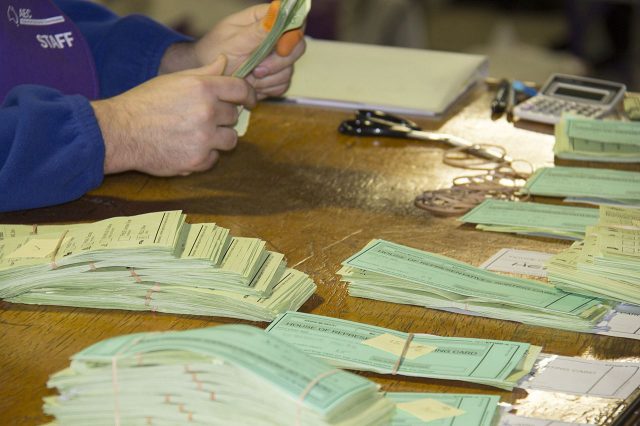
Two coming elections will have massive implications for Australia’s external relations. The outcome of the US 2018 mid-term elections will determine the course of the final two years of Donald Trump’s presidential term. The result of the Australian federal election will determine how Australia responds.
The US mid-terms will take place on 6 November. At stake is Republican control of both chambers of Congress. The latest date for a simultaneous House and half-Senate election in Australia is 18 May 2019. In both instances, there’s a real chance of a shift in power.
The US elections appear to be the most open-ended. Recent generic polls give the Democrats an average national advantage of 4%, although survey results vary widely. Trump-era politics have proven to be volatile and deeply partisan, and the contests for individual House of Representatives and Senate seats are dependent on local issues, demographics, election funding and personalities. Still, potentially the Democrats could wrest back control of one or both chambers.
A status quo result would strengthen Trump’s political position. Another Republican Congress would be even more inclined to fall in behind the administration’s foreign policy agenda. Were the Republicans to suffer significant losses, then manoeuvring and positioning for the next Republican presidential nomination could undermine the party’s cohesion.
The status quo would also give the Pompeo–Bolton axis a relatively free hand and US policy could become more aggressive and abrasive in East Asia and the Middle East. Allies would be consulted less and their concerns dismissed more frequently, and the administration’s behaviour would become more hostile towards multilateral institutions. Regime change and confrontation with Iran would become key policy objectives, and tensions in East Asia would rise with a greater testing of US strength against China in the region.
Democrat control of either congressional chamber is less expected. If the Democrats did take control of both chambers, the administration is likely to be bogged down—if not by impeachment proceedings, then by intrusive congressional investigations and legislative resistance. A Democrat-controlled Senate would greatly complicate the administration’s domestic agenda. The fundamental policy differences on issues like health care, climate change, immigration and abortion would guarantee confrontation. Foreign policy would be a battleground.
How Australia positions itself for the second half of Trump’s term is critical. If the long run of polls going against the Coalition government were a reliable guide, then dealing with the fallout of the US mid-terms would be a problem for an incoming Labor government. But polls aren’t always reliable, as John Howard demonstrated in 2001.
At the next election, Australians might be voting for fundamentally different foreign and defence policies. The draft national platform paper for debate at the upcoming Labor Party national conference has a single passing reference to ANZUS, and the sections covering foreign and defence policy in general are light-on. Although it’s a very different type of document to the defence and foreign affairs white papers the Coalition recently produced, the contrast with the government’s strong alignment with the US in official policy documents is stark.
Foreign and defence policies don’t generally play a major role in Australian electoral politics. However, whichever party forms government next will confront a demanding set of challenges. Although unlikely, it would be valuable if the political parties themselves provoked a serious debate and consciously made external affairs an election issue.
A Republican victory in both chambers could free the US administration to incite a new war in the Middle East. Where would each Australian political party see the national interests being engaged? Similarly, if diplomacy is unable to bring about North Korean denuclearisation, do they propose to commit Australia to any US military solution?
These are not simple binary questions. China, the EU, Russia, Japan, India, South Korea and other nations with varying geopolitical weight, and differing economic significance for Australia, will also have substantial interests in these regions. Australia’s actions in response to crises in the Middle East and East Asia are certain to have short- and long-term consequences for the nation’s security and economy.
If, on the other hand, the Democrats gain some control of Congress, how do the alternative Australian governments propose to position Australia in an era in which what remains of US leadership might stutter as US politicians are distracted by internecine partisan struggles? A Trump administration hampered by a hostile House or Senate might strike out unpredictably internationally or find itself largely obstructed. Undoubtedly other powers like China, Russia and Iran would take advantage of any faltering of US leadership to strengthen their own positions, undermine the US alliances, and reshape the international environment.
The world faces a once-in-a-generation realignment of power and a fundamental transformation in international relations. Much of the shape of the future international environment is difficult to predict. More than any government since the mid-20th century, the next Australian government is likely to face momentous decisions in foreign and defence policy formulation. It will face uncertainty, discontinuity and novelty. It will need imagination, foresight, courage and flexibility.
The coming Australian election is an opportunity to elevate the public debate on the immanent stresses in foreign and defence policy. The uncontested givens behind past electoral contests—US global leadership, the value of ANZUS and the postwar international order—are now sources of uncertainty. Peace is no longer assured. The answers aren’t easy. The old shibboleths will no longer suffice. Strategic policy will need to be about more than funding and defence industry.
The alternative governing parties need to be pressured to show why voters should have the confidence to trust them to navigate these dangerous times.

